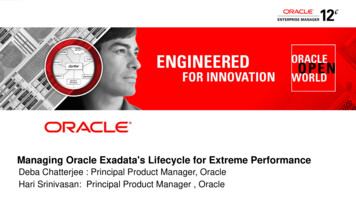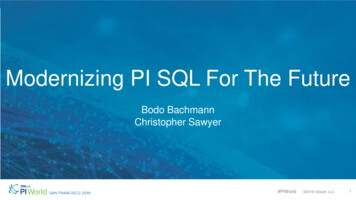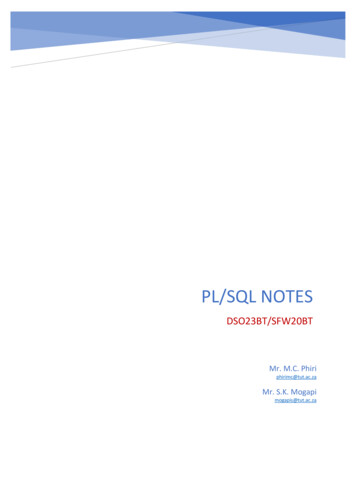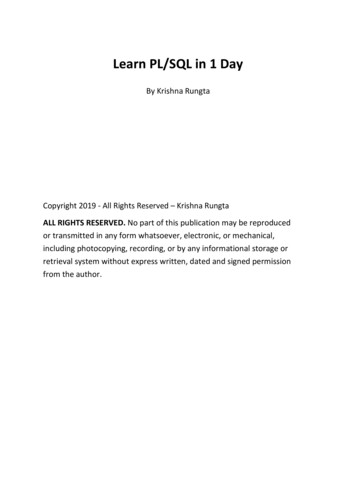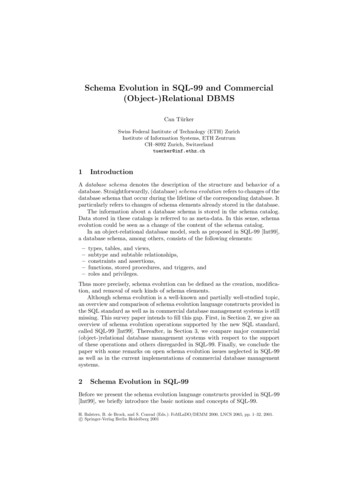
Transcription
Schema Evolution in SQL-99 and Commercial(Object-)Relational DBMSCan TürkerSwiss Federal Institute of Technology (ETH) ZurichInstitute of Information Systems, ETH ZentrumCH–8092 Zurich, Switzerlandtuerker@inf.ethz.ch1IntroductionA database schema denotes the description of the structure and behavior of adatabase. Straightforwardly, (database) schema evolution refers to changes of thedatabase schema that occur during the lifetime of the corresponding database. Itparticularly refers to changes of schema elements already stored in the database.The information about a database schema is stored in the schema catalog.Data stored in these catalogs is referred to as meta-data. In this sense, schemaevolution could be seen as a change of the content of the schema catalog.In an object-relational database model, such as proposed in SQL-99 [Int99],a database schema, among others, consists of the following elements:–––––types, tables, and views,subtype and subtable relationships,constraints and assertions,functions, stored procedures, and triggers, androles and privileges.Thus more precisely, schema evolution can be defined as the creation, modification, and removal of such kinds of schema elements.Although schema evolution is a well-known and partially well-studied topic,an overview and comparison of schema evolution language constructs provided inthe SQL standard as well as in commercial database management systems is stillmissing. This survey paper intends to fill this gap. First, in Section 2, we give anoverview of schema evolution operations supported by the new SQL standard,called SQL-99 [Int99]. Thereafter, in Section 3, we compare major commercial(object-)relational database management systems with respect to the supportof these operations and others disregarded in SQL-99. Finally, we conclude thepaper with some remarks on open schema evolution issues neglected in SQL-99as well as in the current implementations of commercial database managementsystems.2Schema Evolution in SQL-99Before we present the schema evolution language constructs provided in SQL-99[Int99], we briefly introduce the basic notions and concepts of SQL-99.H. Balsters, B. de Brock, and S. Conrad (Eds.): FoMLaDO/DEMM 2000, LNCS 2065, pp. 1–32, 2001.c Springer-Verlag Berlin Heidelberg 2001
2C. Türker2.1Basic Schema ElementsThe main concept for representing data in SQL-99 is the concept of a table,which is made up by a set of columns and rows. A table is associated with aschema and an instance:– A schema of a table specifies the name of the table, the name of each column,and the domains (data types) associated with the columns. A domain istypically referred to by a domain name and has a set of associated values.Examples for basic domains (built-in data types) in SQL-99 are INTEGER,REAL, NUMERIC, CHAR, or DATE.– An instance of a table schema, called table, is a set of rows where each rowhas the same structure as defined in the table schema, that is, each row thesame number of columns and the values of the columns are taken from thecorresponding domain.A table is either a base table or a derived table. A derived table is a table that isderived from one or more other tables by the evaluation of a query expression.A view is a named derived table.Besides the standard built-in data types, SQL-99 provides a row type constructor, an array type constructor and a reference type constructor. A row typeconstructor is used to define a column consisting of a number of fields. Any datatype can be assigned to a field. The array type constructor is also applicableto any data type, whereas the applicability of the reference type constructor isrestricted to user-defined types only.A user-defined type is a named data type. SQL-99 distinguishes two kindsof user-defined types: (1) distinct types which are copies of predefined datatypes and (2) structured types which define a number of attributes and methodspecifications. Every attribute is associated with a data type, which itself canalso be a user-defined type.Structured types can be set into a subtype relationship. A subtype implicitly inherits the attributes and method specifications from its supertype. Everystructured type may have at most one direct supertype. That is, SQL-99 doesnot support multiple inheritance.A table that is created based on a structured type is called a typed table.Typed tables can be organized within a table hierarchy. A table can be a subtableof at most one direct supertable. All rows of a subtable are implicitly containedin all supertables of that table. Analogously to (base) tables, views can be typedand organized in view hierarchies.A table column may rely on a built-in data type, row type, user-defined type,reference type, or collection type. The same holds for an attribute of a structuredtype.SQL-99 furthermore supports the following concepts:– Domains are named sets of values that are associated with a default valueand a set of domain constraints.– Assertions are named constraints that may relate to the content of individualrows of a table, to the entire content of a table, or to the contents of morethan one table.
Schema Evolution in SQL-99 and Commercial (Object-)Relational DBMS3– Routines (procedures and functions) and triggers are named execution unitsthat are used to implement application logic in the database.– Roles and privileges are used to implement a security model. A role is anamed group of related privileges which can be granted to users or roles.To sum up, domains, user-defined types, tables, views, assertions, routines (procedures and functions), triggers, roles, and privileges are the basic schema elements in SQL-99. A database schema is formed by a set of schema elementdefinitions and it evolves by adding, altering, or removing schema element definitions. It is important to note that some schema evolution operations may alsohave an effect on the actual database objects, for instance, on the rows of atable. In the following, we will see which language constructs are provided inSQL-99 to evolve a database schema. Before, to give an overview of the availableoperations, we summarize the main schema evolution operations in Table 1.Table 1. Main Operations of Schema Evolution in —XX———DROPXXXXXXXXXXCreating, Altering, and Removing a DomainThe syntax of the definition of a domain is as follows:1CREATE DOMAIN domain-name [AS ] data-type [ default-clause ] [ domain-constraint-list ] default-clause :: DEFAULT default-value domain-constraint :: [ constraint-name ] check-constraint [ characteristics ]1In the following grammars, terminal and non-terminal symbols are distinguishedusing different font types. Optional symbols are enclosed by [] brackets. The symbol is used to list alternatives.
4C. Türker characteristics :: [[NOT ] DEFERRABLE ]INITIALLY {IMMEDIATE DEFERRED }A domain constraint is expressed by a check constraint which restricts the valuesof the specified data type to the permitted ones. The default clause is used tospecify a default value for the domain.The characteristics clause specifies the checking mode of a constraint. Thechecking mode determines the relative time when the constraint has to bechecked within a transaction. In the immediate mode, the constraint is checkedat the end of each database modification (either an insert, update or delete SQLstatement) that might violate the constraint. In the deferred mode, the checkingis delayed until the end of the transaction.In addition, the characteristics clause determines the initial checking mode,which must be valid for the constraint at the beginning of every transaction. Onlydeferrable constraints can be set to the deferred mode. The checking mode ofa non-deferrable constraint always is immediate. The modes initially immediateand non-deferrable are implicit, if no other is explicitly specified. If initially deferred is specified, then non-deferrable shall not be specified, and thus deferrableis implicit.The checking mode of a constraint can also be changed during the executionof a transaction using the following command:SET CONSTRAINTS {ALL constraint-name-list }{IMMEDIATE DEFERRED }Example 1. Suppose in our application domain, three different cities are distinguished: ’Munich’, ’London’, and ’Paris’. The “default city” is ’Munich’. Such adomain can be created as follows:CREATE DOMAIN cities CHAR (6)DEFAULT ’Munich’CHECK(VALUE IN (’Munich’, ’London’, ’Paris’));2The definition of a domain can be changed by setting/removing the default valueor by adding/removing a constraint to/from the domain. The syntax of the alterdomain statement is as follows:ALTER DOMAIN domain-name alter-domain-action alter-domain-action :: SET default-clause DROP DEFAULT ADD domain-constraint DROP CONSTRAINT constraint-name For each column that is based on the domain to be altered by removing thedefault value, the dropped default value is placed in that column if it does notalready contain a default value. Analogously, for each column that is based onthe domain to be altered by removing a domain constraint, the dropped domainconstraint is attached to the constraint list of that column.A domain can be dropped from the database schema using the followingcommand:
Schema Evolution in SQL-99 and Commercial (Object-)Relational DBMS5DROP DOMAIN domain-name {RESTRICT CASCADE }If RESTRICT is specified, then the domain must not be referenced in any of thefollowing: table column, body of an SQL routine, query expression of a view, orsearch condition of a constraint.Let c be a column of a table t that is based on a domain d. If CASCADE isspecified, then removing d results in the following modifications of c:– The domain d is substituted by a copy of its data type.– The default clause of d is included in c, if c does not contain an own defaultclause.– The constraints of d are added to the table t.2.3Creating, Altering, and Removing a User-Defined TypeThe main corpus of the syntax of the definition of a user-defined type is asfollows:CREATE TYPE type-name [UNDER type-name ][AS { predefined-type attribute-def-list }][{INSTANTIABLE NOT INSTANTIABLE }]{FINAL NOT FINAL }[ ref-type-spec ] [ method-spec-list ] attribute-def :: attribute-name data-type [ ref-scope-check ] [ default-clause ] ref-scope-check :: REFERENCES ARE [NOT ] CHECKEDON DELETED ref-action ref-action :: NO ACTION RESTRICT CASCADE SET NULL SET DEFAULT ref-type-spec :: REF USING predefined-type REF FROM ( attribute-name-list ) REF IS SYSTEM GENERATEDAn attribute is a component of a structured type. A reference attribute is basedon the reference type. The reference scope check clause shall only be specifiedfor such reference attributes. Using this clause, one can specify whether and howto react on the deletion of a referenced instance. The reference type specificationdefines the way how the reference is created.Every user-defined type is instantiable by default, that is, an instance of auser-defined type can be created unless it is explictly disallowed by specifyingthe keyword NOT INSTANTIABLE.
6C. TürkerThe under clause is used to create a subtype of another structured type. Inthis way, type hierarchies can be built. The under clause shall not be used fordistinct types since it is obviously not reasonable. Let type2 be a subtype oftype1, then type2 inherits all attributes of type1. Here, type2 shall not containany attribute that has the same name as an inherited one. That is, attributeredefinition is not allowed.The final clause indicates whether or not the structured type can be usedas a supertype. Surprisingly, the keyword NOT FINAL must always be specifiedwithin the definition of a structured type. If the under clause is specified, thereference type specification is prohibited. For each attribute of a structured typeobserver and mutator methods are generated. These methods are used to accessand modify the value of an attribute.In case of the definition of a distinct type, the keyword FINAL must alwaysbe specified, while neither the under clause nor the reference type specificationare allowed.2Example 2. The following statement defines a distinct type:CREATE TYPE swiss francs AS DECIMAL (12,2) FINAL;A structured type is defined as follows:CREATE TYPE address AS cityVARCHAR(25),VARCHAR(30)country) NOT FINAL;The types defined above can now also be used within the definition of anotherstructured type:CREATE TYPE employee AS (SMALLINT,idROW(first VARCHAR(15), last VARCHAR(20)),nameaddressaddress,supervisor REF(employee) REFERENCES ARE CHECKEDON DELETE SET NULL,DATE,hiredatesalaryswiss francs) NOT FINAL;In this case references are checked automatically whenever an instance of the referenced type is deleted. If the deletion concerns an actually referenced instance,then the attribute supervisor of the referencing instance is set to NULL.We now define a subtype of the structured type above:2Since the keywords NOT FINAL and FINAL must always be used without any options, it is not understandable why they have been introduced.
Schema Evolution in SQL-99 and Commercial (Object-)Relational DBMS7CREATE TYPE manager UNDER employee AS (bonusswiss francs) NOT FINAL;Managers are thus modeled as special employees having an additional bonussalary.2An existing structured type can also be changed by adding new attributes ormethod specifications and by removing existing attributes or method specifications. The main corpus of the syntax of the alter type statement looks asfollows:ALTER TYPE type-name alter-type-action alter-type-action :: ADD ATTRIBUTE attribute-def DROP ATTRIBUTE attribute-name RESTRICT ADD method-spec DROP routine RESTRICT routine :: {PROCEDURE FUNCTION } routine-name The attribute or routine to be dropped shall not be contained in any of thefollowing: body of an SQL routine, query expression of a view, search conditionof a constraint or assertion, or trigger action.A user-defined type is dropped using the following command:DROP TYPE type-name {RESTRICT CASCADE }If RESTRICT is specified, then the user-defined type to be dropped, among others, shall not be referenced in any of the following: another user-defined type,expression of a view, search condition of a constraint or assertion, or triggeraction.2.4Creating, Altering, and Removing a TableAs already mentioned, there are two types of tables: (1) usual tables as knownfrom the previous SQL standard and (2) typed tables which are based on astructured type.The main corpus of the syntax of a table definition is follows:CREATE TABLE table-name {( table-element-list ) OF type-name [UNDER table-name ][( table-element-list ) ]} table-element :: column-def table-constraint-def REF IS column-name ref-generation column-name WITH OPTIONS option-list
8C. Türker column-def :: column-name type-or-domain-name [ ref-scope-check ] [ default-clause ][ column-constraint-def-list ] column-constraint-def :: [CONSTRAINT constraint-name ] column-constraint [ characteristics ] column-constraint :: NOT NULL UNIQUE PRIMARY KEY CHECK ( search-condition ) ref-spec ref-spec :: REFERENCES table-name ( column-name-list )[MATCH {SIMPLE PARTIAL FULL }][ON UPDATE ref-action ] [ON DELETE ref-action ] table-constraint-def :: [CONSTRAINT constraint-name ] table-constraint [ characteristics ] table-constraint :: UNIQUE ( VALUE ) UNIQUE ( column-name-list ) PRIMARY KEY ( column-name-list ) CHECK ( search-condition ) FOREIGN KEY ( column-name-list ) ref-spec ref-generation :: SYSTEM GENERATED USER GENERATED DERIVED option-list :: [ scope-clause ] [ default-clause ][ column-constraint-def-list scope-clause :: SCOPE table-name A usual table is defined by specifying a column list, whereas a typed table isdefined using the of clause with the name of a structured type. In the lattercase, the attributes of the structured type determines the schema of the table.The column options are used to define default values and constraints for a typedtable.Using the under clause, table hierarchies can be built by setting typed tablesinto a subtable relationship. The typed table specified in the under clause refersto the direct supertable of the created typed table. Every typed table may haveat most one direct supertable. Besides, a subtable must not have an explicitprimary key.Let table1 be a table of type type1 and table2 a table of type type2. If table1occurs in the under clause of the definition of table2, then type2 must be a directsubtype of type1.
Schema Evolution in SQL-99 and Commercial (Object-)Relational DBMS9Example 3. The following statement defines a typed table based on the structured type introduced in Example 2:CREATE TABLE employees OF employee;A subtable of this table is defined using the under clause, for instance, as follows:CREATE TABLE managers OF manager UNDER employee;Note this table has the same schema as the following usual table:CREATE TABLE managers (SMALLINT,idnameROW(first VARCHAR(15), last VARCHAR(20)),);addressaddress,supervisor REF(employee) REFERENCES ARE CHECKEDON DELETE SET NULL,DATE,hiredatesalaryswiss francs,bonusswiss francsA main difference between these two kinds of managers tables is that the rowsof the typed table can be referenced in the sense of object-orientation. That is,there may be a reference column referring to an instance of that typed table.In this case, the value of the reference column is a row (or object) identifierassociated with a row of the typed table. In contrast, the only way to referencea row in a usual table is to use the foreign key concept. Here, the value of the(referencing) foreign key must match the value of a (referenced) unique/primarykey of that table.2The definition of a table can be changed using the alter table statement, whichhas the following syntax:ALTER TABLE table-name alter-table-action alter-table-action :: ADD [COLUMN ] column-def ALTER [COLUMN ] column-name col-action DROP column-name {RESTRICT CASCADE } ADD table-constraint-def DROP constraint-name {RESTRICT CASCADE } col-action :: SET default-clause DROP DEFAULT ADD scope-clause DROP SCOPE {RESTRICT CASCADE }The alter table statement can only be applied to base tables. A typed table,however, cannot be altered. Usual base table can be altered by adding and
10C. Türkerremoving columns and constraints. Besides, an existing column of such a tablecan be altered by setting/removing the default value. Furthermore, the scope ofa reference column can be added or removed. A scope can only be added if thereference column does not already have one.If RESTRICT is specified for the drop column clause, then the column to bedropped shall not be contained in any of the following: body of an SQL routine,query expression of a view, search condition or triggered action of a trigger, orsearch condition of a table constraint.A primary key can only be added to a table that has no supertable.If RESTRICT is specified for the drop constraint clause, then the followingmust hold: neither a table constraint nor a view shall be dependent on the tableconstraint to be dropped and its name shall not be contained in the body of anySQL routine body.A table is dropped from the database using the following command:DROP TABLE table-name {RESTRICT CASCADE }Removing a table means that the table schema as well as the table instance areremoved together with the corresponding privileges.If RESTRICT is specified, then the table to be dropped shall not have anysubtable, and moreover it shall not be referenced in any of the following: bodyof an SQL routine, scope of the declared type of an SQL routine parameter,query expression of a view, search condition or triggered action of a trigger,search condition of a check constraint of another table, search condition of anassertion, or a referential constraint of another referenced table. If CASCADE isspecified, such dependent schema elements are dropped implicitly.2.5Creating and Removing a ViewSQL-99 supports two types of views: (1) usual views and (2) typed views thatare based on a structured type.The main corpus of the syntax of the view definition is as follows:CREATE VIEW table-name {( column-name-list ) OF type-name [UNDER table-name ][( column-option-list ) ]}AS query-expression [WITH CHECK OPTION ] column-option :: column-name WITH OPTIONS scope-clause A usual view is defined by a column list, whereas a typed view is specified usingthe of clause which determines the schema of the view. The column option listis used to specify the scope of reference columns.The under clause is used to create a subview of another typed view. In thisway, view hierarchies can be built. The typed view specified in the under clause
Schema Evolution in SQL-99 and Commercial (Object-)Relational DBMS11refers to the direct superview of the created typed view. Every typed view mayhave at most one direct supertable.Let view1 be a view of type type1 and view2 be a view of type type2. If view1occurs in the under clause of the definition of view2, then type2 must be a directsubtype of type1.The check option ensures that all data modification statements performedon the view will be validated against the query expression of that view.Example 4. Assuming there is a structured type employee and a typed tableemployees, the following statement defines a typed view:CREATE VIEW cheap employees OF employee AS (SELECT * FROM employees WHERE salary 5000);2A view definition cannot be altered, but it can be dropped using the followingstatement:DROP VIEW table-name {RESTRICT CASCADE }If RESTRICT is specified, then the view to be dropped shall neither have anysubviews nor it shall be referenced in any of the following: body of an SQLroutine, scope of the declared type an SQL routine parameter, query expressionof another view, search condition or triggered action of a trigger, search conditionof a check constraint of another table, search condition of an assertion, or areferential constraint of another referenced table. If CASCADE is specified, suchdependent schema elements are dropped implicitly.2.6Creating and Removing an AssertionAn assertion is created using the following statement:CREATE ASSERTION assertion-name CHECK ( search-condition )[ characteristics ]In constrast to the search condition of a column constraint or a table constraint,the search condition of an assertion may also refer to more than one row of oneor more tables, that is, table-level and database-level check constraints can bedefined within an assertion.An existing assertion is dropped from the database using the following statement:DROP ASSERTION assertion-name
122.7C. TürkerCreating, Altering, and Removing a RoutineA routine in SQL-99 refers to a procedure or function. The main corpus of thesyntax of a procedure and function definition is as follows:CREATE PROCEDURE routine-name ( parameter-list ) routine-characteristics routine-body CREATE FUNCTION routine-name ( parameter-list ) returns-clause routine-characteristics routine-body Loosely spoken, a function is a procedure with an additional return clause. Aroutine can be specified with different characteristics. For instance, a routinecan be either an SQL or an external routine, it can be deterministic or nondeterministic, and it can be a routine that only reads or modifies SQL data. Theroutine body consists of an SQL procedure statement.A routine can also be altered and dropped, respectively, using the followingcommands:ALTER routine alter-routine-characteristics RESTRICTDROP routine-name {RESTRICT CASCADE }If RESTRICT is specified, then the routine to be dropped shall not be referencedin any of the following: body of an SQL routine, query expression of a view, searchcondition of a check constraint or assertion, or triggered action of a trigger. IfCASCADE is specified, such dependent schema elements are dropped implicitly.2.8Creating and Removing a TriggerThe syntax of a trigger definition is as follows:CREATE TRIGGER trigger-name {BEFORE AFTER }{INSERT DELETE UPDATE [OF column-name-list ]}ON table-name [REFERENCING old-or-new-values-list ][FOR EACH {ROW STATEMENT }][WHEN ( search-condition ) ] SQL-procedure-stat BEGIN ATOMIC SQL-procedure-stat-list END old-or-new-values :: {OLD NEW } [ROW ] [AS ] correlation-name {OLD NEW } TABLE [AS ] table-alias A trigger is implicitly activated when the specified event occurs. The activationtimes before and after specify when the trigger should be fired, that is, eitherbefore the triggering event is performed or after the triggering event. Valid triggering events are the execution of insert, update, or delete statements. A triggercondition and trigger action can be verified and executed, respectively, for each
Schema Evolution in SQL-99 and Commercial (Object-)Relational DBMS13row affected by the triggering statement or once for the whole triggering event(for each statement). Trigger conditions and actions can refer to both old andnew values of the rows affected by the triggering event.An existing trigger can be dropped using the following command:DROP TRIGGER trigger-name 2.9Creating and Removing RolesThe create role statement has the following syntax:CREATE ROLE role-name [WITH ADMIN OPTION grantor ]After the creation of a role, no privileges are associated with that role. Thesehave to be added using the grant statement, as described in the following. Theadmin option is used to give the grantee the right to grant the role to others, torevoke it from other users or roles, and to drop or alter the granted role.An existing role is dropped using the following statement:DROP ROLE role-name 2.10Granting and Revoking PrivilegesPrivileges are granted to a user or role using the grant statement, which has thefollowing syntax:GRANT {ALL PRIVILEGES privileges-or-role-name-list }TO grantee-list [WITH HIERARCHY OPTION ] [WITH GRANT OPTION ][WITH ADMIN OPTION ] [GRANTED BY grantor ]The hierarchy option can only be applied to privileges on typed tables or typedviews. It specifies that the granted privileg is also valid for all subtables (subviews) of a typed table (typed view). The grant option is used to specify thatthe granted privileg is also grantable, that is, the user is allowed to give othersthe privileg to access and use the named object. In general, the hierarchy andgrant options shall only be specified when privileges are granted while the adminoption shall only be specified when roles are granted.A granted privileg or role can be revoked from a user or role using the revokecommand. The syntax of the revoke command is as follows:REVOKE [{GRANT HIERARCHY ADMIN } OPTION FOR ]{ALL PRIVILEGES privileges-or-role-name-list }FROM grantee-list [GRANTED BY grantor ]{RESTRICT CASCADE }Analogously to the grant statement, the hierarchy and grant option shall onlybe specified when privileges are revoked, while the admin option can only bespecified when roles are revoked.
14C. TürkerExample 5. The following statement creates a role reademp. This role is associated with the privileg to read the data of all kinds of employees:CREATE ROLE reademp;GRANT SELECT ON employee TO reademp WITH HIERARCHY OPTION;The hierarchy option ensures that all users associated with the role reademp arealso allowed to read the data of any special employee, for instance, the salary ofa manager.It is also possible to revoke only the hierarchy option from the role reademp.This is achieved by executing the following statement:REVOKE HIERARCHY OPTION FOR SELECT ON employee FROM reademp;Using the statement above without the hierarchy option revokes the privileg toselect any employee.23Comparison of Schema Evolution Constructs inSQL-99 and Commercial DBMSIn this section, we compare the schema evolution language constructs of SQL99 [Int99] with that of the commercially available (object-)relational databasemanagement systems Oracle8i Server (Release 8.1.6) [Ora99], IBM DB2 Universal Database (Version 7) [IBM00], Informix Dynamic Server.2000 (Version 9.2)[Inf99], Microsoft SQL Server (Version 7.0) [Mic99], Sybase Adaptive Server(Version 11.5) [Syb99], and Ingres II (Release 2.0) [Ing99]. In the following, wewill use the abbreviations Oracle, DB2, Informix, MSSQL, Sybase, and Ingres,respectively, to refer to these systems. In addition, we will use the term reference systems to refer to all of these systems as a whole. It should be pointedout that in fact only Oracle, DB2, and Informix could be denoted as objectrelational database management systems. The other three systems are pure relational database management systems.3.1Domains and AssertionsNeither the concept of a domain nor the concept of an assertion is supported byany reference system.However, there are a few rudimentary approaches in that directions. Ingres,for instance, provides the concept of an integrity rule which actually correspondsto a row-level assertion. Internally, these integrity rules are stored with a generated integer number, which is used to identify an integrity rule within a tabledefinition. This number is needed, for instance, to drop an integrity rule. Anintegrity rule is created and dropped, respectively, as follows:CREATE INTEGRITY ON table-name IS search-condition DROP INTEGRITY ON table-name {ALL integer-list }
Schema Evolution in SQL-99 and Commercial (Object-)Relational DBMS15The creation of an integrity rule fails if the table contains a row that does notsatisfy the search condition. In the Ingres manuals, there is a hint to define checkconstraints within a create table or alter table statement instead of specifyingintegrity rules that anyway are not conform to the standard
{ functions, stored procedures, and triggers, and { roles and privileges. Thus more precisely, schema evolution can be de ned as the creation, modi ca-tion, and removal of such kinds of schema elements. Although schema evolution is a well-known and partially well-studied topic,



